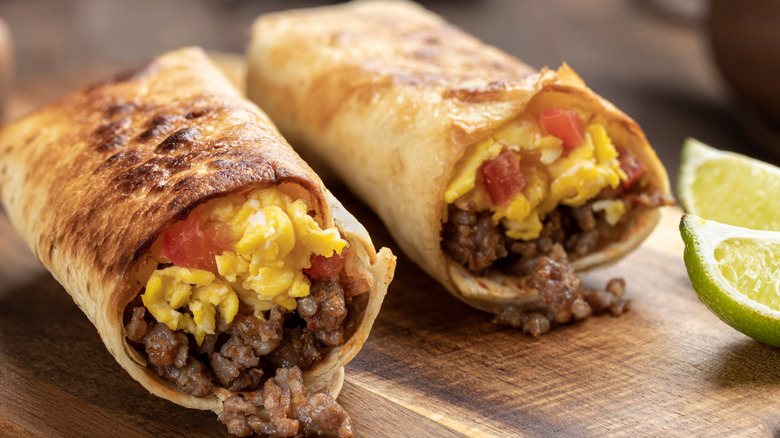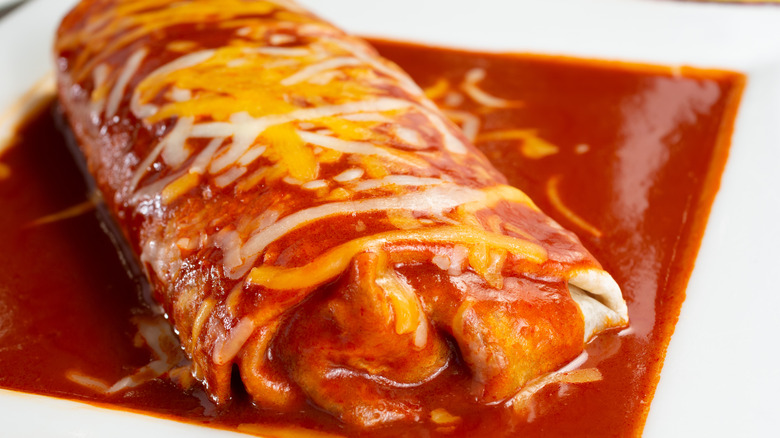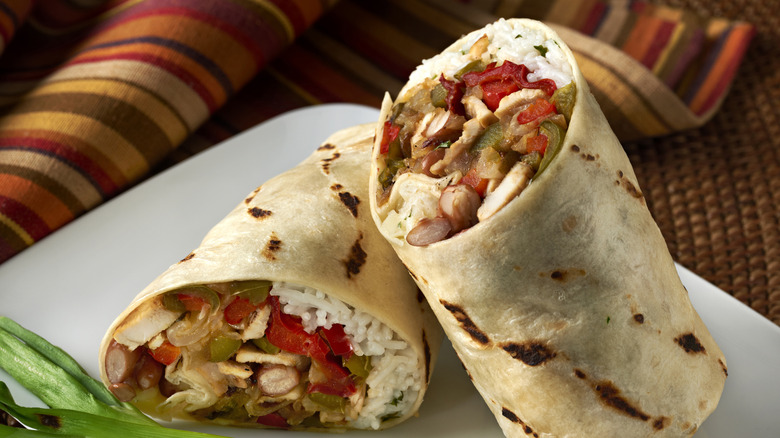Prevent A Sad Soggy Burrito With One Toasty Tip
While Homer Simpson might have chanted, "Where's my burrito," the beloved cartoon character did not want a soggy, broken mess to fall apart after a single bite. Instead of a busted burrito, a toasted tortilla can keep all the ingredients folded into that tight package.
Generally, a burrito is made with a flour tortilla. While that easily foldable texture makes for a tight roll, flour can absorb liquid from the wet ingredients inside the burrito. From the salsa to the lettuce to even the ground beef, many of the ingredients have moisture, which can seep into the tortilla and reduce its structural integrity.
Instead of grabbing the fork in preparation for the pending bust, toasting the burrito can help seal in all the ingredients and avoid the soggy burrito disaster. The crisp outside creates a stronger barrier. Placing the seam side down in a pan, panini press, or griddle is like putting a piece of tape on the edges of a wrapped present. Once that side is toasted, flip it over to the other side for another beautifully brown, crispy edge. While some people may use a little oil to enhance crunchy texture, a hot surface works on its own.
Wet burritos need to be toasted before getting sauced
From a rich mole to a bright verde sauce, a wet burrito creates a multi-textural, sublime bite. But, if that tortilla is not toasted to a golden brown before being smothered, the sad, soggy plate is not a dish that will get rave reviews.
The crispy, crunchy sealed burrito does more than keep the wet ingredients from seeping out into a messy bite. While the Maillard reaction causes a flavorful, visually enticing brown appearance, it also creates a stronger barrier to keep sauces and other liquids from crossing into the food. Although it is not impenetrable, it does slow down the absorption.
With a wet burrito, the toasted texture has two aspects that keep the smother and the covered not crossing into each other's territories. In addition to the crunchy, toasted texture, the oil that is used to toast the burrito in the pan adds another layer. Oil and water are immiscible. It helps to create a separation between the two ingredients. Even though the first cut into that well-sealed burrito allows the sauce to flood into the whole dish, the toasted barrier does its job until that moment of enjoyment.
Carefully layering ingredients can help present soggy burritos
From the carefully stacked BLT to a juicy hamburger on a brioche bun, stacking the ingredients in a particular order ensures that the first bite does not crumble into a disaster. Since no one wants a mushy, messy burrito, properly layering the ingredients can help to avoid a busted outcome.
Similar to how the toasted tortilla creates a barrier, stacking ingredients to keep wetter ingredients away from the surface can help to lessen a soggy situation. For example, a layer of cheese, rice, or beans directly on top of the tortilla can help. It will not be an impenetrable surface, but it will slow the absorption.
In addition, putting wetter ingredients, like salsa, tomatoes, or even ground beef in the center of the burrito helps. It is not as delineated as the partition on a child's plastic plate, but it is better than just scooping ingredients without any thought.
From toasting to layers, a better homemade burrito can be achieved with a few simple steps. Hopefully, the wait for that scrumptious bite will not be as arduous as Homer Simpson's quest.


